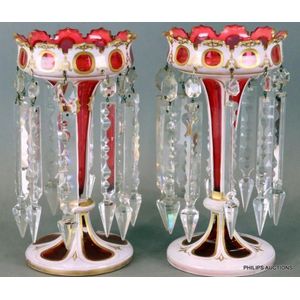19th Century Bohemian White Overlay Cranberry Glass Lustres Pair
A pair of Bohemian white overlay cranberry glass lustres, 19th century the fine pair of lustres, each with ogee bowl with gilt-lined castellated rim and decorated with thumb cut border enriched in gilt, above a tapering and knopped cut stem edged with gilt bands, on a conforming circular foot, the bowl suspending ten facet cut spear prism drops. Height 27 cm
You must be a subscriber, and be logged in to view price and dealer details.
Subscribe Now to view actual auction price for this item
When you subscribe, you have the option of setting the currency in which to display prices to $Au, $US, $NZ or Stg.
This item has been sold, and the description, image and price are for reference purposes only.
- Overlay Glass - Overlay glass is coloured glass that has been created by sandwiching two or more layers of different coloured glass together. The layers are fused together through a process of heating and melting in a glass furnace, and the resulting glass has a unique colour and depth that is not found in single-layered glasses.
The technique of overlaying glass has been used for centuries, and was particularly popular in the Venetian glass industry during the Renaissance. Different colours of glass were layered to create intricate designs, and then the layers were carved and etched to create intricate patterns and details. - Faceting - Faceting is a technique of removing material from a curved surface, to give a series of flat surfaces but retaining the profile of the original surface.
The technique is most commonly associated with diamond cutting where the various cuts used such as rose cut and brilliant cut, add life and sparkle to the stone, whilst at the same time removing as little of the stone as possible.
Faceting by grinding is also used to decorate glass. The stems of many drinking glasses are decorated by cutting a series of flat surfaces on a circular stem, and hollow vessels such as vases may have faceted surfaces.
In furniture faceting is often applied to legs of tables and chairs, where a circular baluster shaped section is flattened so as to form an octagonal section. - Cranberry Glass - Cranberry glass is a type of glass that is characterized by its deep red color. It was first made in the 19th century and was particularly popular during the Victorian era. It was typically used to make decorative items such as vases and figurines. The red color was achieved by adding gold chloride or selenium to the glass mixture during the manufacturing process.
- Knop (glass) - In Georgian glassware, the knop is a bulbous protrusion, usually midway up the stem of the glass. It may be included singly or in groups, and may be hollow or solid. There are many styles of knop including basal, baluster, bell, acorn, cone, flattened, melon and mushroom.
This item has been included into following indexes:
